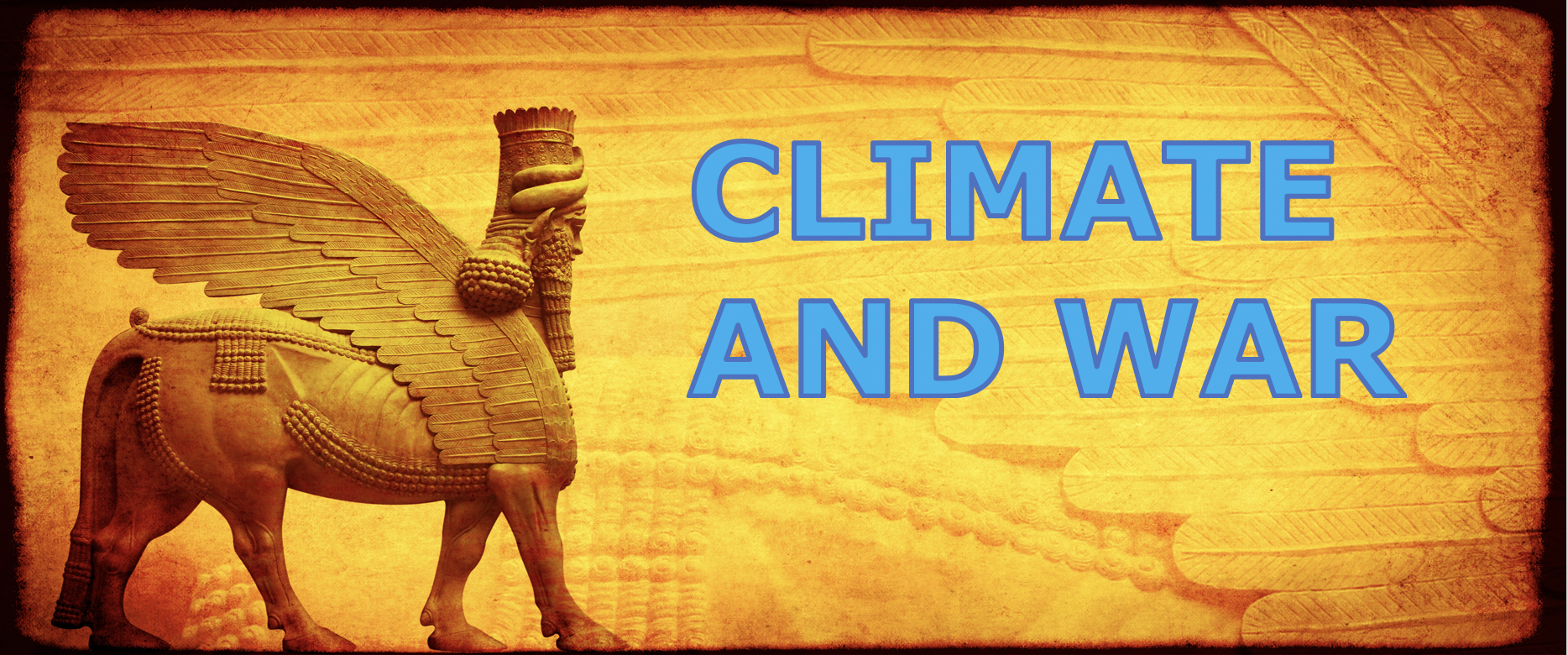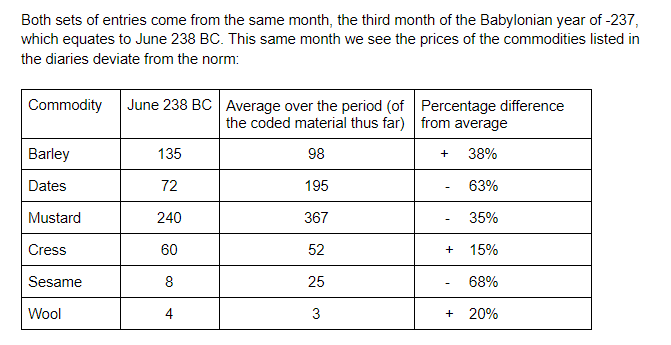Climate and War: the Importance of Babylonia and Assyria

Authors Conor Kostick and Rhonda McGovern
It seems intuitively obvious that there is a connection between climate and war. When the climate worsens resulting in droughts, flooding and other extreme events, isn’t it likely that food production will decline? And that this in turn will lead to great tension between neighbouring states? This is a plausible hypothesis, yet it hasn’t been definitively established. And even if the link between war and climate could be proven, doing so wouldn’t necessarily help with actionable policy unless it came with a better understanding of the mechanisms by which extreme weather events contribute to conflict.
The Climates of Conflict in Ancient Babylonia research project, funded by the Irish Research Council, has been looking at a very rich dataset with a view to providing a clear answer as to the relationship between climate and war.
The historical records of Babylonia and Assyria
There are two reasons why the records of Babylonia and Assyria are the right place to look for a link between severe weather and warfare: they are extensive and they are detailed. Written records in the region around the Tigris and Euphrates rivers go back as far as c.3100 BCE, preserved on clay tablets. Of course, the further back in time you go, the rarer the records become and a significant body of material is required for testing a hypothesis about the impact of climate on warfare. We are therefore looking at the records of the first millennium BCE, for which there is a relative abundance. As for the content of these records, it really is quite extraordinary.
The Assyrian and Babylonia elites of the era were absorbed by prophecies and believed not only that their fate was indicated by celestial and terrestrial omens, but that death and disaster could be averted by the appropriate apotropaic rituals in response to the divine signs. This theological outlook led the priesthood and nobility to an almost scientific cataloguing of events with potential significance for prophecy and a body of canonical texts to which priests could refer to guidance in interpretations.
There are thousands of records, therefore, of this type:
Line 1: [If] there is an eclipse in Sivan (III) on the 14th day, and the (moon) god in his eclipse becomes dark on the east side above, and clears on the west side below, the north wind rises during the evening(!) watch and touches the middle watch: you observe his eclipse and keep the north wind in mind; thereby a decision is given for Ur and the king of Ur: the king of Ur will experience famine; deaths will become many; as for the king of Ur, his son will wrong him, but Šamaš will catch the son who wronged his father, and he will die in the mourning-place of his father; a son of the king who had not been named for kingship will seize the throne.
Line 9: An eclipse in the morning watch portends sick people becoming well; the term of the morning watch is 10 months. Reverse Line 7: If there is an eclipse in Sivan (III): there will be a flood, and the water will carry off the land. Reverse Line 14: If there is an eclipse in Sivan (III) at an un-appointed time: the king of the universe will die, and Adad will devastate; a flood will come, Adad will diminish the harvest of the land; a leader of troops will fall.
This was a missive sent by Issar-šumu-ereš, the Assyrian chief scribe, to his king, Esarhaddon in the year 669 BCE. The lunar eclipse indicates the date of this communication: 11 June that year. The eclipse is the event, the prophecies are famine, many deaths, civil strife leading to insurrection, violent flood and the death of a general. Grim reading for Esarhaddon who would, in fact, die later that year. Fortunately, the king had steps he could take to avert these consequences of the eclipse, namely the performance of certain rituals.
Note that there is no evidence from the communication that violent flood took place, nor the famine or civil strife. As we study these records, however, it seems that there is some flexibility for the priest in regard to interpretation of the prophetic event (in this case the eclipse). While the canonical texts obliged Issar-šumu-ereš to state all the associated implications (many other astrologers would have written to the king with the same quotations and the king himself was capable of checking the citations) the order in which they were set out and and whether they were written on the front or reverse of the tablet are significant and there was enough scope in interpretation for some scholars to shift apparently evil omens to becoming good ones.
A lot of our work therefore involves identifying events that actually happened (such as reports of extreme weather) and sifting through the various interpretations of the meaning of the events for indications that some real societal consequence was underway, such as a famine. We are helped here by the direct evidence contained within accounts of the deeds of kings or even of the indirect evidence of words attributed to gods, such as the text in which Aššur, head of the Assyrian pantheon, is described as saying about Šamaš-šumu-ukīn, king of Babylon 668 - 648 BCE: “In his time his people were seized by famine; they chewed leather straps. I {the God,} made [......] to seize the people of Akkad, and I made them eat each other's flesh [......].”
Overall, there is an abundance of material for the investigation of climate and war, especially in comparison to that available in the sources for Europe. Even a thousand years later, the scribes of early medieval Europe were producing nothing like this quantity of written content.
The Astronomical Diaries, Extreme Weather and War
Within the overall corpus of Babylonian and Assyrian works there is a distinct type of record which modern scholars have grouped together as the ‘Astronomical Diaries’. These diaries contain five types of data: sub-daily astronomical and meteorological observations, monthly historical data, prices for six commodities, and river level heights. The smallest resolution we have for these is at two hour intervals for the sub daily reported observations of meteorological and astronomical phenomena; the largest is at the monthly resolution, with the exception of gaps in the data through missing or broken tablets. These herald the boring and mundane entries:
“Night of the 5th, beginning of the night, [the moon was] 2 cubits [in front of] 𝛽 Virginis. Night of the 6th, beginning of the night, [....]. [The 6th, Saturn’s first appearance in Taurus,] rising of Saturn to sunrise: 20° (ideal) first appearance on the 1st. Night of the 7th, beginning of the night, the moon was 1 cubit [in front of] 𝛼 Virginis, it was set towards its inside.”
… alongside the more exciting entries:
“That month, there were many deaths; in (one) house, 2 or 3 died. That [month], there was fighting in the area of the palace which is in Babylon [….] That month, the 29th and 30th, when the troops from the palace came out, with the guard troops of the king. [….] …. That month? …. [….] locusts kept [attacking].

Assessing price data, against meteorological data and meteorological extremes, alongside the historical information recorded in the diaries, provides us with great insight into the difficulties faced by the people of Babylon in times of war or extreme climate events. Changes to the price of food staples can result in starvation and death for some of the population through an inability to buy or sell at reasonable cost, as seen in this example above. Although further inquiry is needed to examine this fully as mitigation strategies were employed by kings to reduce the impacts of war or climate disasters on food availability through methods of releasing stored food commodities, or adjusting prices.
Impacts of climate events are seen in the diaries also: “The earth quaked” recorded on the 19th of the 12th month in the Babylonian calendar, or March 251 BC. It was followed with a monthly river recording that indicated flooding: “The river level rose above the apertures of the peak flood; at the end of the month it receded 1 cubit”.
These examples give us a ‘sneak peak’ into the wealth of information held within the Astronomical Diaries. This project will code all the material from the diaries and run statistical analysis on it, this will provide a concrete picture of what the diaries can tell us about the Ancient Babylonians and their ability to adjust to changing circumstances through climate events and violence.
So do Babylonian and Assyrian sources prove a link between climate and war?
Drum roll… Probably. At the time of writing this blog, we are at about the halfway stage of this project and the pattern does seem to bear out the contention that times of severe weather (drought, excessive floods and cold periods) are also times of increased warfare and societal stress. Naturally, we want to ensure we have statistically robust findings before we make the research public and naturally too, we want the feedback of our peers before having full confidence in our conclusions. For now, therefore, we can’t go further than to say that the link appears to be a likely one. What we can offer here are some insights into the possible mechanisms through which climate events might lead to increased warfare.

